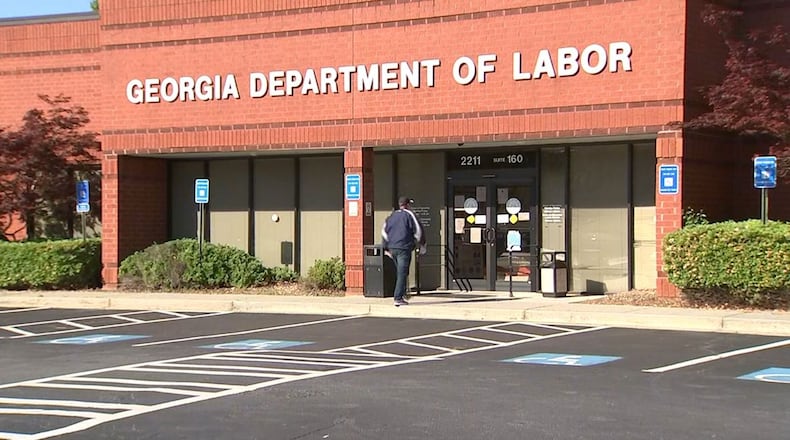As the economy shuttered during the COVID-19 pandemic, a wave of Georgians suddenly without work rushed to apply for unemployment benefits. In one month alone, more than 1.3 million workers applied, overwhelming a system that at the height of the Great Recession handled just over 125,000 claims in a month.
For state Rep. Bill Werkheiser, a Glennville Republican and chairman of the House Industry and Labor Committee, that meant frustrated constituents contacting him. “Every day I was giving (the state Department of Labor) a spreadsheet of names that seemed to be hung up in the system,” he said.
Three years later, Werkheiser rarely gets a call. The unemployment rate in Georgia has fallen dramatically, and the number of people applying for unemployment benefits in the state has returned to normal levels.
As focus on Georgia’s unemployment system recedes thanks to the absence of a crisis, the Labor Department is working to prepare for the next one by addressing problems that were exposed during the pandemic. They include securing more funding from the state, working to improve communications with state officials and residents, and modernizing the unemployment benefits system itself.
But while the pandemic shined a light on the urgency of supporting an agency that observers say was neglected for too long, solutions will take time to implement, leaving it uncertain how prepared Georgia will be for the next inevitable economic downturn.
A ‘siloed’ department
Since Labor Commissioner Bruce Thompson stepped into his role in January, he has said the department has an image problem. “A lot of it culminated during the pandemic,” he said, “but it really was because of the contentiousness of the past.”
That contentiousness can be seen through what both Thompson, previously a state senator, and Werkheiser said was a rocky relationship between the previous labor commissioner and the General Assembly and governor’s office.
Over time, some of the responsibilities of the Labor Department have been siphoned off to other state agencies. That has left it somewhat hollowed out from what it once was, going from more than 4,000 employees in 2011 to fewer than 900 this year.
“When I came in, you saw evidence on all kinds of fronts on how it’s siloed itself internally and externally,” Thompson said.
But even the responsibilities that remained with the department lost funding. The state provided the Labor Department more than $11 million for unemployment benefits management in the late 2000s. By the late 2010s, that figure was just above $4 million.
Thompson’s predecessor, Mark Butler, believed the agency’s reliance on federal funding made state appropriators see its state budget as flexible. But in the years leading to the pandemic, federal funding also fell, as happens during strong economic periods when fewer people are receiving jobless benefits, causing policymakers to divert revenue away from managing the program.
Credit: Bita Honarvar, bhonarvar@ajc.com
Credit: Bita Honarvar, bhonarvar@ajc.com
“We’re always playing catch-up,” Butler said. “We were one of the few entities that gets more money during a recession and then less money when times are good.”
Reliance on federal funding leaves the department vulnerable, said Ray Khalfani, senior policy analyst at the Georgia Budget and Policy Institute. “State funding is still very important to be able to help them manage those ebbs and flows of federal funding,” he said.
When the volume of claims swelled as the pandemic hit, delays began. Despite Labor Department management encouraging overtime, hiring contractors and even retirees to help manage the claims, claimants struggled to get benefits. Delays left applicants without income, digging into their savings, and those qualifying for pandemic-era federal programs had to wait to apply until the agency could update its computer systems. During the worst of it, just over half of claimants received their first benefits payments within 35 days of applying.
Even today, there are still claimants with appeals from the past few years saying they never got payments they believe they’re owed.
Turnaround
A 2022 state audit of the Labor Department’s handling of the pandemic concluded that the crisis was worsened by underlying weaknesses within the agency. It primarily found weak communications and a too-manual system hindered its response, and that the agency struggled to provide reliable data and track inquiries by claimants.
The department told The Atlanta Journal-Constitution it has updated its online portal for unemployment claimants, adding additional security measures and a tracker for claimants to know the status of their claim, the latter an audit recommendation. It also has begun to automate the claims appeals process, identifying requests and creating case files without manual intervention, and is using artificial intelligence to help manage telephone and digital inquiries.
During this year’s legislative session, the General Assembly brought back the administrative assessment, part of the employers tax that funds unemployment insurance, after letting it lapse for a year. Rather than the revenue from the assessment going to the benefits’ trust fund, it goes to Labor Department operations.
The renewal of the assessment also included new language that makes clear its revenue is for the Labor Department. In the past, revenue from it has been given to other departments, too. But even with the explicit legislative language, Thompson said it’s not a guarantee his agency will get all the funds.
Miriam Gutman, senior staff attorney for economic justice at the Southern Poverty Law Center, said the return of the assessment is good news but more needs to be done. “It’s really critical for their budget to be increased in addition,” she said, “not back to only what it was before.”
The department’s budget for unemployment benefits management increased in fiscal 2024 to its highest level in more than a decade. Thompson said that was thanks to persuading appropriators to believe in investment.
It also is due to the state having massive budget surpluses the past three years, with every state agency seeing a boost in spending since the early days of the COVID-19 pandemic.
But the hardest challenge could be yet to come. The agency is looking to overhaul its software that runs the claims, tax and appeals unemployment benefits system, soliciting a request for a private contractor to help. Thompson said the department’s current software is from the 1980s, making it one of the oldest in the nation.
Changes that have been made so far have been to the underlying old system’s code, but a completely new one will be more efficient and transparent, Thompson said. He wants to get it done within two years after a contractor is found.
But the system will likely cost about $50 million, he said, meaning the department will have to work to get even more state funding. Thompson has confidence it will get it.
“Our case will be simple: This is not an investment into us, it’s an investment into the people through the process of modernizing.”
Lingering concerns
While nowhere near pandemic levels, problems remain. Federal Department of Labor data shows fewer than 73% of claimants in Georgia received their first check 21 days after filing in June. That shows troubles getting out benefits persist, even at a time when the state unemployment rate is 3.2%, as opposed to 12.4% in April 2020.
Those payment delays, and the persistent appeals backlog, could be solved by a modernized system, Thompson said. It could more quickly detect fraud, which he said is still occurring at elevated levels compared with before the pandemic, and deal with claims accurately to avoid problems.
The 870-member staff Thompson has remaining in the department is smaller than before the pandemic. In 2019, the agency had 1,055 employees. But Thompson said he believes staffing cuts will stop now and he’ll be able to make a more efficient agency with the current total, rather than hiring more people.
Gutman, who has been having quarterly meetings with the department as part of a lawsuit settlement reached last year, said the progress so far is a good sign. “It’s been really encouraging,” she said. “The department is really trying.”
Thompson said he is happy with the progress made so far. But while he’s confident once a system modernization occurs the department will be ready for anything, until then he’s less sure, especially if another rapidly unfolding crisis happens again.
“We are now preparing this agency to be resilient enough that we would be able to incrementally handle anything that would be thrown our way,” he said. “But we’ve got a ways to get there.”
About the Author
Keep Reading
The Latest
Featured




